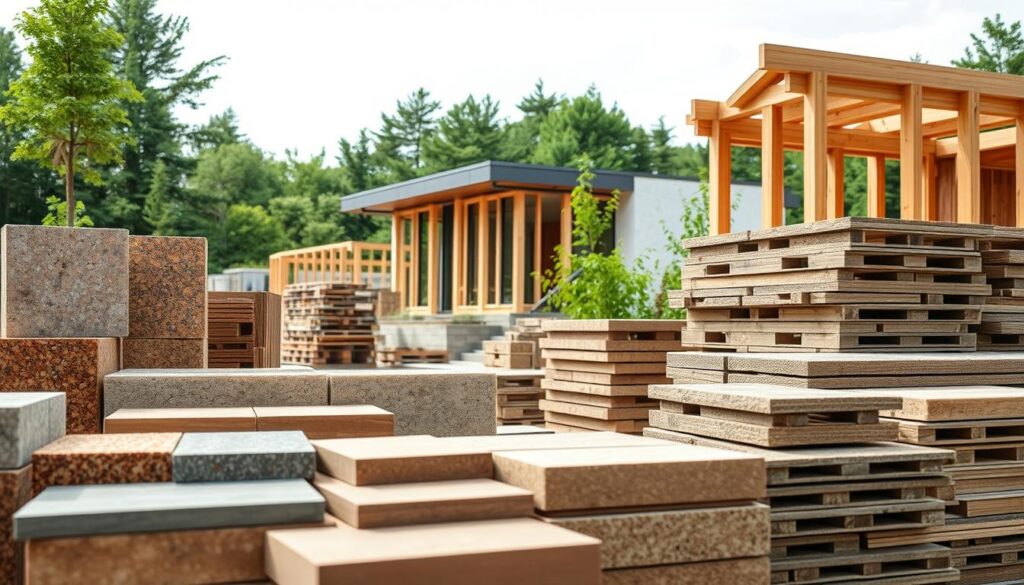Australians are now more aware of their environmental impact. This awareness has led to a growing demand for sustainable homes. We're seeing a big move towards eco-friendly construction methods. These methods not only help our planet but also offer quality, comfort, and style.
Modular housing is leading this change. It brings a new way to build homes. This approach cuts down on waste, lowers energy use, and makes homes that are good for the environment and appealing.
Australia's housing sector is changing fast. This change is due to growing worries about the environment. The old ways of building homes are facing big environmental challenges. This is pushing for more green housing options.
Old building methods harm the environment a lot. They create a lot of waste, produce a lot of carbon, and use resources badly. In Australia, building is a big waste maker, with lots going to landfills. Also, the carbon footprint of old construction is huge, adding to climate change.
Key statistics highlight the severity of the issue:
Modular construction is seen as a good answer to these environmental problems. It uses factory processes to cut down waste and make buildings better. More Australians want homes that are good for the planet, without sacrificing quality or durability.
The benefits of modular construction include:
As Australia's housing market keeps changing, modular building is set to be key in making homes more sustainable.
Modular eco homes are changing the Australian housing market. They are built with the environment in mind. This means they use less energy and are more comfortable.
One big plus of modular eco homes is how they are made. They are built in a factory. This means less waste from the start.
Building homes in a factory has many benefits. It means better quality, protection from the weather, and standard processes. All these help make homes more sustainable.
Key benefits of controlled manufacturing include:
Modular homes make less waste than traditional ones. They use about 30-40% less. This is because of how materials are managed and recycled in the factory.
For instance, excess materials can be reused or recycled, minimizing the amount of waste sent to landfills. This makes modular homes a cleaner choice for building.
Modular homes have a lower carbon footprint than traditional ones. This is because they use materials and energy more efficiently in factories.
Also, modular homes can be made to use less energy. They have better insulation and can use renewable energy. This lowers their carbon footprint even more.
Australian prefab eco homes lead the way in sustainable building. They offer a greener option compared to traditional building methods.
Modular homes in Australia are leading the way in energy efficiency. They use new design and technology. This makes them better for the environment and saves money for homeowners.
These homes are at the forefront of sustainable living in Australia. They show how important energy efficiency is.
Modular homes have advanced insulation and thermal design. They are built in factories, where insulation is installed precisely. This keeps homes warm in winter and cool in summer.
They use special insulation and air sealing. This keeps the temperature inside steady. It makes homes more comfortable and uses less energy.
Modular homes are made to work with renewable energy systems. This includes solar panels, batteries, and smart energy management. It's easier than adding these to old homes.
This approach helps homeowners use less grid power. It also lowers their energy bills.
Modern modular homes use many energy-saving designs. These include passive solar, thermal mass, cross-ventilation, and energy-efficient appliances. These designs work together to save energy and improve comfort.
For example, passive solar design uses the sun's light and heat. This reduces the need for artificial lighting and heating. Thermal mass uses materials that absorb and release heat, helping to control the home's temperature.
By using these designs, modular homes in Australia save a lot of energy. Homeowners enjoy lower bills and a smaller carbon footprint. As more people want sustainable homes, energy-efficient modular homes will play a big role.
Modular homes are leading the way in eco-friendly living. They use sustainable materials and manage resources well. This reduces harm to the environment.

The modular construction industry is moving towards eco-friendly materials. It uses recycled steel frames, sustainably harvested timber, low-VOC finishes, and recycled insulation materials. These choices help reduce environmental impact while keeping costs down.
Water conservation is key in sustainable modular homes. They often have rainwater harvesting systems, greywater recycling, water-efficient fixtures, and drought-resistant landscaping plans. The controlled factory setting helps install plumbing systems accurately, saving water.
Using local materials in modular construction cuts down on emissions and supports local economies. It ensures materials are right for Australia's climate. The controlled supply chain helps track materials' origins and environmental impact, boosting sustainability.
The modular housing industry is making big strides towards a greener future. By using sustainable materials and managing resources well, it's making affordable green prefab homes more accessible to Australians.
Australia is moving towards sustainable living, and modular housing is leading the way. It causes less damage to the environment compared to traditional building methods. The construction industry is a big polluter, but modular homes offer a greener option.
The construction time for modular homes is 30-50% shorter than usual. This means less damage to soil, plants, and wildlife. It helps keep the natural world intact.
Also, using less heavy machinery and fewer deliveries cuts down on fuel use and emissions. Modular construction is a cleaner way to build homes.
Modular homes are easy to move, which reduces waste and extends their life. They are made to be disassembled and reassembled for sustainability.
This makes them adaptable and eco-friendly. Homeowners can move or reuse their homes, cutting down on waste and environmental harm.
Modular designs fit well in Australia's different environments. They can handle bushfires, cyclones, coastal areas, and the outback. They are built to work with the land, not against it.
They preserve natural drainage and vegetation, blending into their surroundings. This is key to avoiding harm to Australia's unique ecosystems.
In the future, modular housing will change how we live sustainably in Australia. The sector is growing fast, thanks to new tech and a need for green homes.

New South Wales is leading in sustainable modular homes. Architects and builders are creating homes that are good for the planet. They use biophilic elements, living walls, and other green features.
These homes are made from sustainable materials and save energy. They also connect us more with nature. Living in these homes makes our living spaces healthier and helps the planet.
Modern modular homes are leading in green design. They use new materials and ideas. Trends like mass timber construction and 3D printing are becoming common.
These homes are also designed to use less waste. They are stylish and functional, making them popular for those who want to live green.
By 2026, we'll see big changes in eco homes. Expect AI energy management, new materials, and homes that make their own energy. We'll also see homes that can heal themselves and use energy very efficiently.
These changes will make homes better for the planet and for us. As tech advances, we'll see even more ways to live sustainably.
In Sydney, trusted modular home builders are leading a green revolution. They mix innovative designs with eco-friendly methods. This change is driven by their commitment to the environment and sustainable building.
Sydney's top modular builders are using new, green building methods. They're doing this by:
These steps not only cut down on carbon emissions. They also set new standards for the industry.
Working with Sydney's trusted modular builders makes green homes affordable. They use efficient production and scale to keep prices low. For example, a 7-star energy-rated modular home can cost the same as a 5-star conventional home. It also saves money on energy bills in the long run.
Many case studies show the green benefits of modular homes in Sydney. For instance, a recent project in Sydney's Northern Beaches:
| Environmental Metric | Modular Home | Conventional Home |
|---|---|---|
| Energy Consumption | 30% less | Baseline |
| Water Usage | 40% less | Baseline |
| Waste Reduction | 85% less construction waste | Baseline |
These stories show real environmental gains from choosing modular homes in Sydney.
As we face climate change and environmental damage, our housing choices are key. Australian prefab eco homes are a great solution. They combine new design, save energy, and cut down on waste.
Modular housing has many environmental benefits. It uses controlled manufacturing to reduce waste and lower carbon emissions. Plus, its energy-efficient designs and use of renewable energy systems help us use less carbon. These steps help make our built environment more sustainable and meet Australia's climate goals.
Our choices about housing affect the environment. Choosing Australian prefab eco homes is a step towards a smaller environmental footprint. These homes are not just green; they're also modern and beautiful, showing Australian innovation and care for the environment.
Adopting modular eco homes could change Australia's housing sector for the better. We need to see the value in these homes and support their use. Together, we can make Australia greener, one home at a time.


